Durable, yet comfortable organic LED fibers can be used for clothing-type displays.
KYUNG CHEOL CHOI AND SEUNGYEOP CHOI, KAIST
It started with the fitness tracker. And thanks to continued advances in sensors, computing power, and energy harvesting, the age of IoT-based wearable technologies is upon us.
For broader adoption, however, tomorrow’s wearable must feature display technology far more prominently. Case in point: Studies suggest that much of the appeal of smartphones stems from the central role of displays in their design.
The current lighting technology for wearable displays is the low-cost and ubiquitous LED. Its complex circuitry and lack
of flexibility, however, make it less than ideal for mobile light sources. With a market projected to reach $61.7 billion by 2020, there is an urgent need for technical innovations for more flexible and smoother displays.
In response, a research team from the Korea Advanced Institute of Science and Technology (KAIST) developed a wearable OLED display1-4 that is both soft and comfortable, with many of the same properties of clothing. And the displays are capable of flexing and bending with the human body, so wearers don’t experience “wearable stress” — a consciousness of wearing devices (Figure 1).
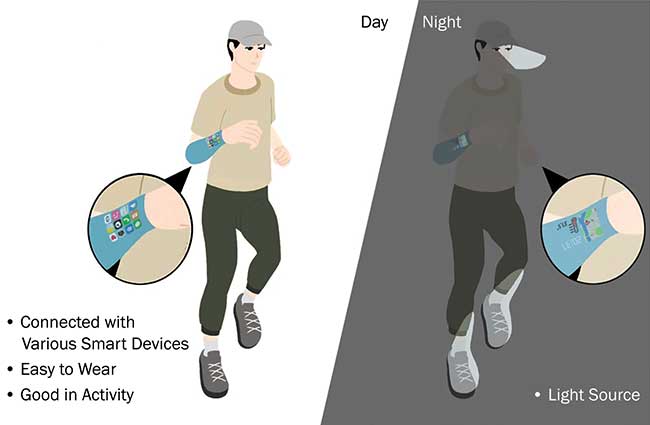
Figure 1. Smart fashion utilizing fabric-based OLEDs. A variety of smart functions are available through fabric-based wearable displays. At night, wearable OLEDs on hats, shoes, and sleeves can be used as lighting. Courtesy of KAIST.
In addition, the team improved the electrical and optical properties of the fabric-based displays and secured long lifetime of the light-emitting device by a transparent and flexible encapsulation5. The OLED fibers showed the highest luminance and current efficiency to date, and their durability against bending strain and fatigue stress was confirmed by mechanical simulation6.
Flattening the fabric
The researchers wove a bundle of fibers several micrometers thick, resulting in an interwoven structure several hundred micrometers thick, and the surface of the fabric had a roughness of several tens of micrometers.
In contrast, OLEDs — lightweight, thin, and flexible — had a total thickness of 200 nm or less. Surface roughness of a substrate of only a few tens of nanometers can cause serious leakage currents in OLEDs and negatively affect operating reliability. Accordingly, a process of flattening the fabric is essential. The team thermally laminated a film of polyethylene naphthalate (PEN) 30 μm thick to the fabric for planarization. The PEN film and the fabric were uniformly joined by applying the roll-to-roll method, conducive to low cost and mass production. The PEN film was selected as the planarization layer because of its very low thermal expansion coefficient of 20 ppm/°C and a glass transition temperature twice as high as that of polyethylene terephthalate (PET).
The surface roughness of the planarized fabric showed a root mean square surface roughness (Rq) of 2.073 nm. In other words, the surface roughness of the fabric was reduced to one-thousandth of what it was before the planarization (Figure 2).
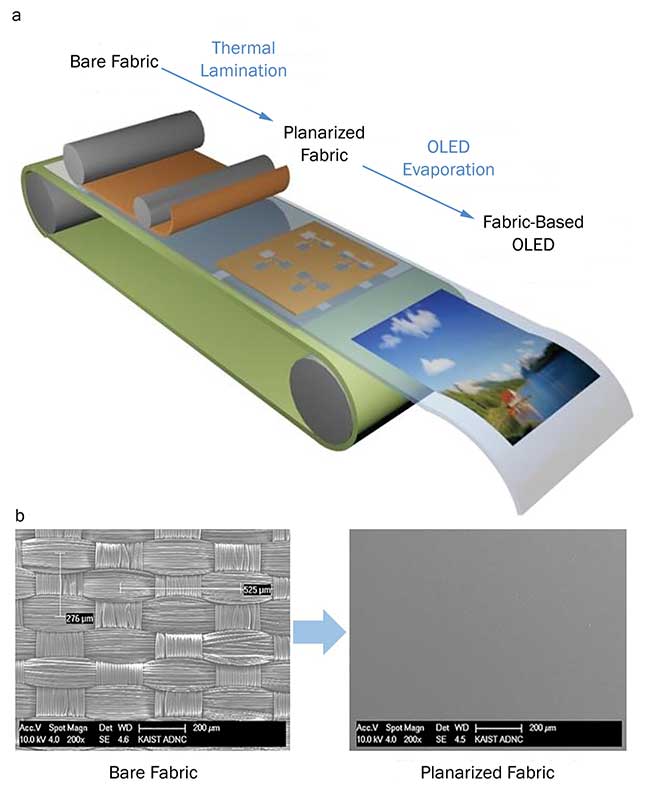
Figure 2. Planarization process of fabric by thermal lamination and OLED formation (a). Surface secondary electron images of fabrics before and after the planarization process (b). From reference 6. Courtesy of KAIST.
OLEDs are very vulnerable to moisture and oxygen. When an OLED reacts with moisture or oxygen, a dark spot that does not emit light is generated, so the encapsulation technique for protecting OLEDs from moisture and oxygen is important. The barrier function of OLED encapsulations is evaluated by the water vapor transmission rate (WVTR). Plastic film usually has a WVTR value of about 10-2 g/m2/day, and OLEDs require a WVTR of 10-6 g/m2/day or less to enable long-term stable driving. To ensure long-term reliability of fabric-based OLEDs, a 1.5-dyad barrier composed of layers of Al2O3, SiNx, and more Al2O3 was inserted below the planarization layer to prevent water vapors and oxygen molecules penetrating from the fabric side.
The fabric had a flat surface over a large area, but there were some abrupt peaks on the surface caused by particles and dust in the laboratory environment. For this reason, despite the very low Rq, the peak-to-valley surface roughness (Rpeak-to-valley) reached 58.924 nm. These high peaks on the surface can cause leakage currents and unstable driving of the OLED. To solve this problem and to secure the long-term lifetime of the OLED, an organic-inorganic hybrid multibarrier technology was applied as the encapsulation of the fabric-based OLED.
The multibarrier is one of the encapsulation technologies that can secure both barrier function and flexibility by alternately forming flexible organic and dense inorganic layers. High-density Al2O3 layers were formed by atomic layer deposition (ALD), and the silane-based polymer was spin-coated between each barrier to improve the flexibility. The fabricated multi-barrier showed the very low WVTR of about 10-6 g/m2/day required by commercialized OLED technology, and the peaks on the planarized fabric were effectively alleviated by spin coating of the silane-based solution. The Rpeak-to-valley decreased significantly — from 58.924 nm to 6.068 nm — after the spin coating, and the fabric-based OLED also showed a decrease in leakage current and an increase in current efficiency.
At the beginning of the research, the KAIST team designed a structure in which OLEDs on the fabric were sandwiched by
a multibarrier. However, during the top-side encapsulation process, the OLEDs were exposed to air containing large amounts of water vapors and oxygen molecules, and dark spots were generated. Also, because water is used as a reactant to form Al2O3 in the ALD chamber, degradation of the OLED during the topside encapsulation process is very severe.
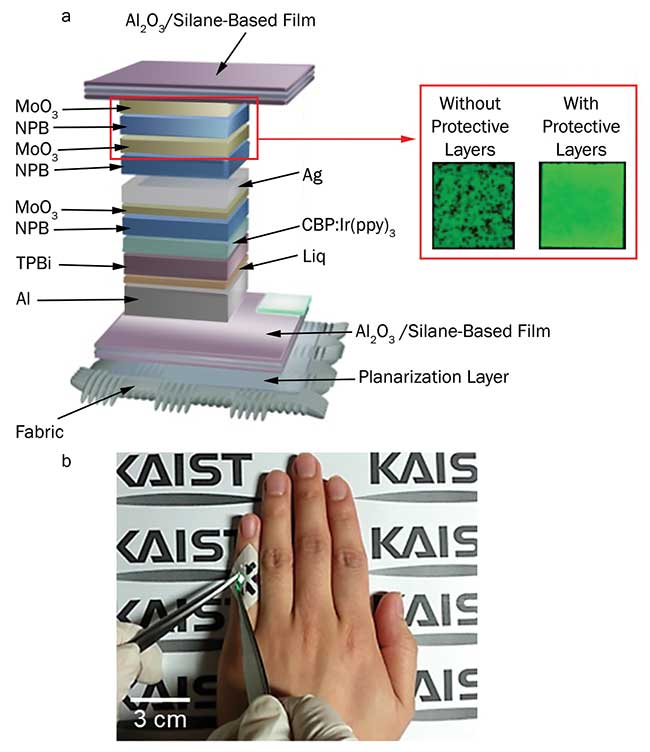
Figure 3. Structure of a fabric-based OLED and cell images with and without protective layers (a). Photograph of a fabric-based OLED bent along the flexion of the fingers (b). From reference 6. Courtesy of KAIST.
To overcome this problem, protective layers were deposited between the OLED and the topside encapsulation in order to delay the time it takes for moisture and oxygen to reach the OLED during the process. The protective layers were designed to have alternating depositions of MoO3 NPB, and MoO3, inspired by the structure of the multibarrier. As a result, it was
confirmed that the degree of dark spot generation of the fabric OLEDs was very different depending on the presence or absence of the protective layer (Figure 3).
Flexibility of fabric-based OLEDs
The fabric-based OLEDs (with PEN) were more flexible compared to PET-based OLEDs of the same thickness. Unlike PET-based OLEDs, which were severely damaged even at a radius of curvature of 10 mm, the fabric-based OLEDs were able to operate reliably even after 1000 cycles of bending at a radius of 3 mm. This means that the fabric with a woven structure of fine fibers has less mechanical strain and stress than the PET film. Note that even though the top of the planarized fabric had a flat surface, the weaving pattern of the fabric appeared in the OLED when a large strain, such as folding (bending radius of 1 mm), was applied (Figure 4).
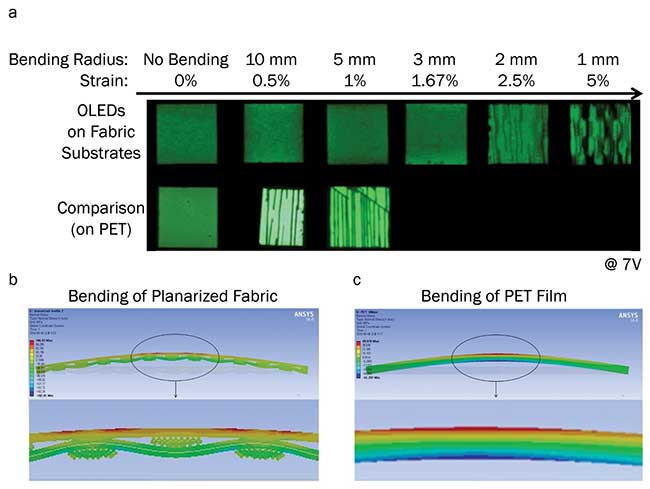
Figure 4. Analysis of bending strains of fabric-based OLEDs. Cell images of OLEDs on fabric and polyethylene terephthalate (PET) after the cyclic bending test (repetition: 1000) (a). Bending motion simulations using finite element method (FEM). Two-dimensional film and planarized fabric structures, and enlarged images (b, c). From reference 6. Courtesy of KAIST.
The reason was found by comparing the planarized fabric and the PET film using a two-dimensional mechanical simulation tool. The fabric had voids inside it and wavy structures of threads, thus some were in contact with the planarization layer and threads, and some were not. At this point, because of the thinness of the unbonded part, the strain was concentrated in the parts where the fabric substrate was bent (Figure 5). This means that the strain generation occurred relatively easily in the unbonded part compared to the bonded part and that the strain on the fabric substrate was not as large as with the PET. It was thus confirmed that void spaces and winding structures inside the fabric contributed to overall flexibility, reduced the mechanical stress, and affected the surface stress distribution on the planarization layer.
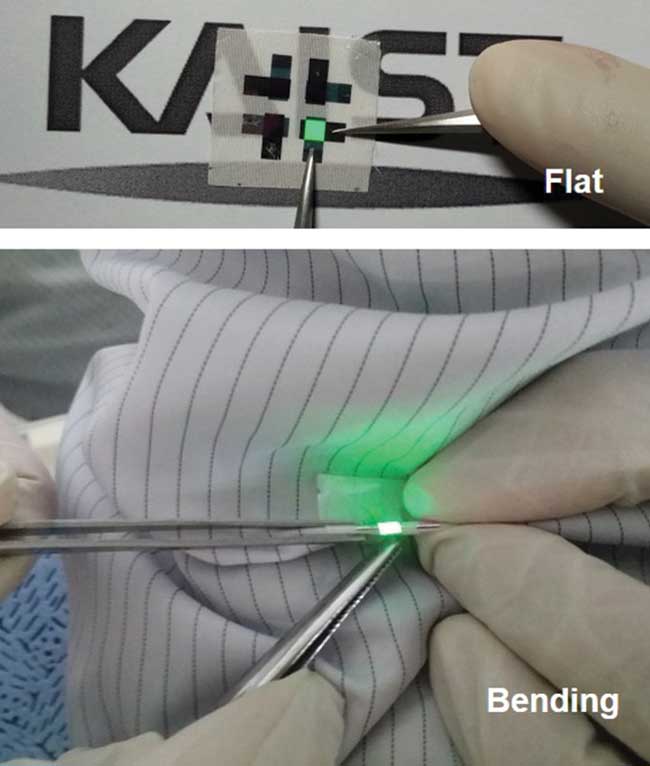
Figure 5. Photographs of fabric-based OLEDs, flat and bending. From reference 6. Courtesy of KAIST.
The previously reported results for fabric-based OLED devices showed that the surface of fabrics was not sufficiently flattened, and stable operations were difficult. The fabric substrate for OLED operation had an Rq of 2.073 nm, and the coefficient of thermal expansion (CTE) was 25.7 ppm/°C at 30 to 180 °C, similar to that of the glass substrate. The team developed methods to improve the operational reliability of the fabric-based OLEDs by applying protective layers to prevent the generation of dark spots during the encapsulation and using the spin-coating process to reduce the peak-to-valley surface roughness.
The fabric-based OLEDs showed almost the same performance as OLEDs fabricated on the glass substrate. Therefore, the fabric-based OLEDs had the highest luminance and current efficiency in the world among the fabric-based light-emitting devices.
OLEDs-on-fabric are poised to become a key technology in smart fashion; wide use is also seen in safety industries and automobile displays. The applications are unlimited with smartphones and various wearable devices. And KAIST researchers are currently working on a follow-up study on the use of fabric-based OLEDs in phototherapy.
Meet the authors
Kyung Cheol Choi, Ph.D., has been a professor at KAIST and a researcher in the display and flexible electronics field for 24 years. He holds a doctorate from Seoul National University and has published more than 180 international academic papers. Choi holds 70 patents; email: [email protected].
Seungyeop Choi is a doctoral candidate, specializing in the research of fabric-like OLEDs; email: [email protected].
References
1. W. Kim et al. (2013). Soft fabric-based flexible organic light-emitting diodes. Org Electron, Vol. 14, Issue 11, pp. 3007-3013.
2. S. Kwon et al. (2015). High luminance fiber-based polymer light-emitting devices by a dip-coating method. Adv Electron Mater, Vol. 1, Issue 9.
3. S. Kwon et al. (2017). Weavable and highly efficient organic light-emitting fibers for wearable electronics: a scalable, low-temperature process. Nano Lett, Vol. 18, Issue 1, pp. 347-356.
4. H. Kim et al. (2015). Solution-processed bottom-emitting polymer light-emitting diodes on a textile substrate towards a wearable display. J Inf Disp, Vol. 16, Issue 4, pp. 179-184.
5. W. Kim et al. (2016). Reliable actual fabric-based organic light-emitting diodes: toward a wearable display. Adv Electron Mater, Vol. 2, Issue 11.
6. S. Choi et al. (2017). Highly flexible and efficient fabric-based organic light-emitting devices for clothing-shaped wearable displays. Sci Rep, Vol. 7, Article no. 6424.